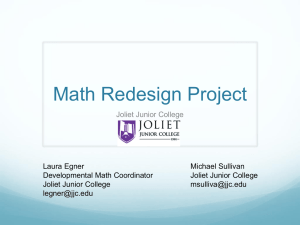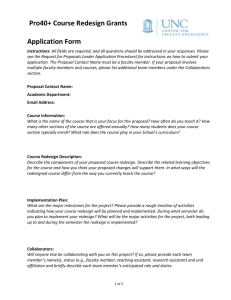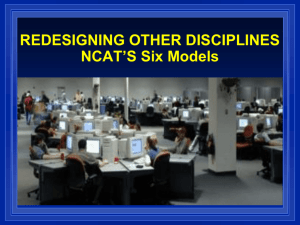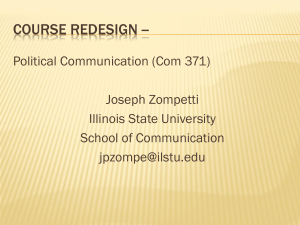Pew Grant Program in Course Redesign
advertisement
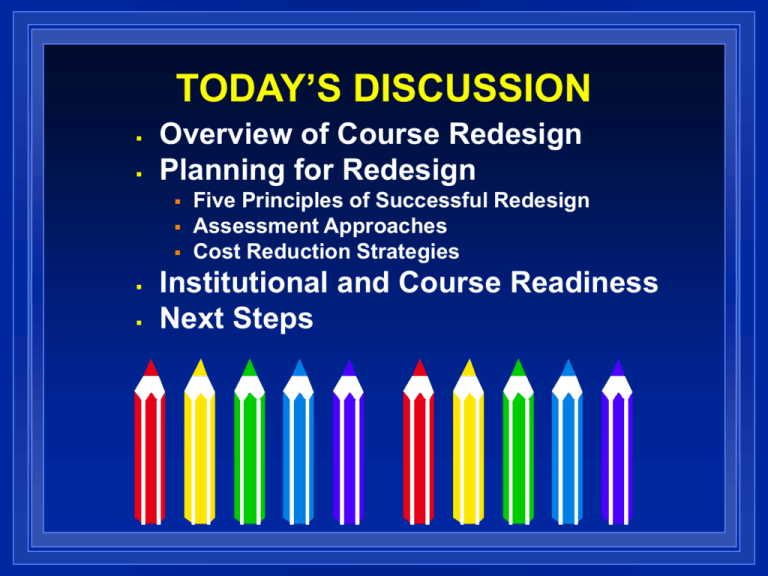
TODAY’S DISCUSSION Overview of Course Redesign Planning for Redesign Five Principles of Successful Redesign Assessment Approaches Cost Reduction Strategies Institutional and Course Readiness Next Steps WHAT DOES NCAT MEAN BY COURSE REDESIGN? Course redesign is the process of redesigning whole courses (rather than individual classes or sections) to achieve better learning outcomes at a lower cost by taking advantage of the capabilities of information technology. PROGRAM IN COURSE REDESIGN Challenge colleges and universities to redesign their approaches to instruction using technology to achieve quality enhancements as well as cost savings. 50,000 students 30 projects ASSUMPTIONS THAT GET IN THE WAY Improving quality means increasing cost Adding IT increases cost Using IT may even threaten quality TRADITIONAL INSTRUCTION Seminars Lectures “BOLT-ON” INSTRUCTION WHAT’S WRONG WITH THE LECTURE? Treats all students as if they are the same Ineffective in engaging students Inadequate individual assistance Poor attendance and success rates Students fail to retain learning WHAT’S WRONG WITH MULTIPLE SECTIONS? In theory: greater interaction In practice: large class size In practice: dominated by the same presentation techniques Lack of coordination Inconsistent outcomes THE ONE PERCENT SOLUTION Maricopa Community College District 200,000 students 2,000 course titles 25 courses = 44% enrollment All CCs = 51% All four-year = 35% QUANTITATIVE (13) Mathematics – – – – – – – Iowa State University Northern Arizona University Rio Salado College Riverside CC University of Alabama University of Idaho Virginia Tech Statistics – – – – Carnegie Mellon University Ohio State University Penn State U of Illinois-Urbana Champaign Computer Programming – – Drexel University University at Buffalo SCIENCE (5) SOCIAL SCIENCE (6) Biology – – Fairfield University University of Massachusetts – University of Iowa U of WisconsinMadison Astronomy – U of ColoradoBoulder Psychology – – – Chemistry – – Sociology – Cal Poly Pomona University of Dayton University of New Mexico U of Southern Maine IUPUI American Government – U of Central Florida HUMANITIES (6) English Composition – – Spanish – – Portland State University University of Tennessee Fine Arts – Brigham Young University Tallahassee CC Florida Gulf Coast University World Literature – University of Southern Mississippi IMPROVED LEARNING OUTCOMES Penn State - 68% on a content-knowledge test vs. 60% UB - 56% earned A- or higher vs. 37% CMU - scores on skill/concept tests increased by 22.8% Fairfield – 88% on concept retention vs. 79% U of Idaho – 30% earned A’s vs. 20% UMass – 73% on tougher exams vs. 61% FGCU - 85% on exams vs. 72%; 75% A’s and B’s vs. 31% USM - scored a full point higher on writing assessments IUPUI, RCC, UCF, U of S Maine, Drexel and U of Ala significant improvements in understanding content 25 of 30 have shown improvement; 5 have shown equal learning. REDUCTION IN DFW RATES U of Alabama – 60% to 40% Drexel – 51% to 38% Tallahassee CC – 46% to 25% Rio CC – 41% to 32% IUPUI – 39% to 25% UNM – 39% to 23% U of S Maine – 28% to 19% U of Iowa – 25% to 13% Penn State – 12% to 9.8% 24 measured; 18 showed improvement. COST SAVINGS RESULTS Redesigned courses reduce costs by 37% on average, with a range of 15% to 77%. Collectively, the 30 courses saved about $3 million annually. WHAT HAPPENS TO THE SAVINGS? Stay in department for continuous course improvement and/or redesign of others Provide a greater range of offerings at upper division or graduate level Accommodate greater numbers of students with same resources Stay in department to reduce teaching load and provide more time for research Redesign similar courses Miscellaneous – Offer distance sections – Reduce rental expenditures – Improve training of part-time faculty REDESIGN CHARACTERISTICS Redesign the whole course—not just a single class Emphasize active learning—greater student engagement with the material and with one another Rely heavily on readily available interactive software—used independently and in teams Mastery learning—not self-paced Increase on-demand, individualized assistance Automate only those course components that can benefit from automation—e.g., homework, quizzes, exams Replace single mode instruction with differentiated personnel strategies Technology enables good pedagogy with large #s of students. FIVE REDESIGN MODELS Supplemental – Add to the current structure and/or change the content Replacement – Blend face-toface with online activities Emporium – Move all classes to a lab setting Fully online – Conduct all (most) learning activities online Buffet – Mix and match according to student preferences SUPPLEMENTAL MODEL Retains the basic course structure, particularly the number of class meetings Supplements lectures and textbooks with technology-based, out-of-class activities Encourages greater student engagement with course content Ensures that students are prepared when they come to class May also change what goes on in the class—e.g., creating an active learning environment GENERAL BIOLOGY at Fairfield University Inconsistent student academic preparation Inadequate student interaction with learning materials and complex topics Inadequate use of modern technology Inability of students to retain what they have learned (amnesia) Inability of students to apply biological principles to other disciplines (inertia) Memorization vs. Application of Scientific Concepts ACADEMIC GOALS Enhance quality by individualizing instruction Focus on higher-level cognitive skills Create both team-based and independent investigations Use interactive learning environments in lectures and labs – – – to illustrate difficult concepts to allow students to practice certain skills or test certain hypotheses to work with other students to enhance the learning and discussion of complex topics Traditional 7 sections (~35) 7 faculty 100% wet labs $131,610 $506 cost-per-student Redesign 2 sections (~140) 4 faculty 50% wet, 50% virtual $98,033 $350 cost-per-student Content mastery: significantly better performance Content retention: significantly better (88% vs. 79%) Course drops declined from 8% to 3% Next course enrollment increased from 75% to 85% Declared majors increased by 4% REPLACEMENT MODEL Replaces (rather than supplements) in-class time with online, interactive learning activities Carefully considers why (and how often) classes need to meet in face-to-face Assumes that certain activities can be better accomplished online—individually or in groups May keep remaining in-class activities the same or may make significant changes May schedule out-of-class activities in 24*7 computer labs or totally online so that students can participate anytime, anywhere FIRST-YEAR SPANISH (Replacement Model) Increase active speaking via in-class interaction Use technology to support skill practice Provide immediate feedback online Increase student and instructor computer literacy Encourage collaborative learning, both online and in class Traditional Redesign 57 sections (~27) Adjuncts + 6 TAs 100% in class $167,074 ($2931/section) 1529 students @ $109 38 sections (~54) Instructor-TA pairs 50% in class, 50% online $56,838 ($1496/section) 2052 students @ $28 Oral skills: significantly better performance Language proficiency & language achievement: no significant difference A second Spanish project: final exam scores in speaking, reading and listening were higher EMPORIUM MODEL Moves all classes to a lab setting Depends heavily on instructional software Allows students to work as long as they need to master the content Can be adapted for the kinds of students at a particular institution Permits the use of multiple kinds of personnel Requires a significant commitment of space and equipment Can teach more than one course in the lab, thus leveraging the initial investment THE MATH EMPORIUM at Virginia Tech Traditional 38 sections (~40) 10 tenured faculty, 13 instructors, 15 GTAs 2 hours per week $91 cost-per-student Redesign 1 section (~1520) 1 instructor, grad & undergrad TAs + 2 tech support staff 24*7 in open lab $21 cost-per-student Replicated at U of Alabama, U of Idaho, LSU, Wayne State, U Missouri-St. Louis, Seton Hall THE EMPORIUM MODEL 77% Cost Reduction (V1) 30% Cost Reduction (V2) FULLY ONLINE MODEL Eliminates all in-class meetings Moves all learning experiences online Adopts successful design elements of other models: commercial software, automated assessments with guided feedback, links to additional resources and alternative staffing models FULLY ONLINE MODEL Traditional Redesign one class Emphasize instructor-tostudent interaction Instructor does all grading and provides all student feedback Use a single personnel strategy Redesign Redesign whole course Emphasize student-tostudent interaction and teaming Automate grading and student feedback Use a differentiated personnel strategy RIO SALADO COLLEGE Pre-Calculus Mathematics Redesign Traditional 4 courses taught by 4 instructors Student interaction = each instructor $49 cost-per-student Retention = 59% 4 courses taught by 1 instructor Student interaction = interactive software, 1 course assistant, and 1 instructor $31 cost-per-student Retention = 65% U. OF S. MISSISSIPPI World Literature Redesign Traditional 16 – 20 sections (~65) Taught by 8 faculty and 8 adjuncts Faculty do all grading $70 cost-per-student Single online section Team-taught by 4 faculty and 4 TAs 50% automated grading via WebCT; 50% TAs $31 cost-per-student Redesign triples course capacity. THE BUFFET MODEL Assess each student’s knowledge/skill level and preferred learning style Provide an array of high-quality, interactive learning materials and activities Develop individualized study plans Build in continuous assessment to provide practice and feedback Offer appropriate, varied human interaction when needed WHAT DO THE FACULTY SAY? “It’s the best experience I’ve ever had in a classroom.” “The quality of my worklife has changed immeasurably for the better.” “It’s a lot of work during the transition-but it’s worth it.” FACULTY BENEFITS Increased opportunity to work directly with students who need help Reduced time spent on grading Technology does the tracking and monitoring More practice and interaction for students without faculty effort Ability to try different approaches to meet different student needs Opportunity for continuous improvement of materials and approaches Program in Course Redesign (PCR) – Roadmap to Redesign (R2R) – 20 institutions Colleagues Committed to Redesign (C2R) – 30 institutions 60 institutions State and System-based Programs – 80+ institutions QUANTITATIVE Mathematics – – – – – – – – – Developmental Math Pre-calculus Math College Algebra Discrete Math Introductory Algebra Elementary Algebra Beginning Algebra Intermediate Algebra Linear Algebra Statistics – – – – Business Statistics Introductory Statistics Elementary Statistics Economic Statistics Computing – – – – – Computer Programming Information Technology Concepts Computer Literacy Information Literacy Tools for the Information Age SCIENCE – – – – – – Anatomy and Physiology Astronomy Biology Ethnobotany Chemistry Geology SOCIAL SCIENCE – – – – – American Government Macro and Microeconomics Psychology Sociology Urban Affairs HUMANITIES – – – – – – – – – – – Developmental Reading Developmental Writing English Composition Communication Studies Understanding the Visual and Performing Arts History of Western Civilization Great Ideas in Western Music Spanish World Literature British Literature Women and Gender Studies PROFESSIONAL – – – – – – – Elementary Education Education: The Curriculum Engineering Technology Organizational Behavior Public Speaking Accounting Nursing FOR MORE INFORMATION www.theNCAT.org Full project plans Monographs Progress reports Planning resources Lessons Learned Project contacts


